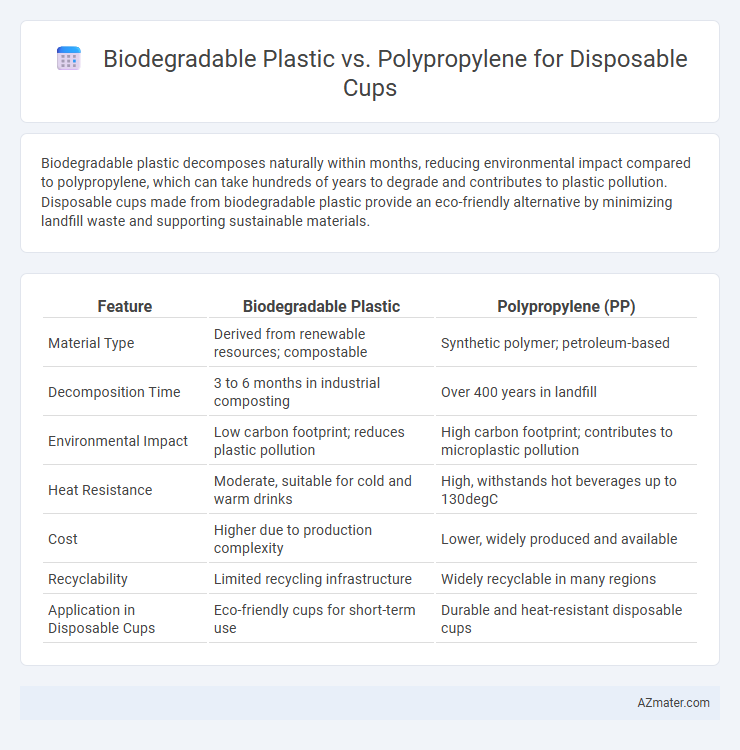Biodegradable plastic decomposes naturally within months, reducing environmental impact compared to polypropylene, which can take hundreds of years to degrade and contributes to plastic pollution. Disposable cups made from biodegradable plastic provide an eco-friendly alternative by minimizing landfill waste and supporting sustainable materials.
Table of Comparison
| Feature | Biodegradable Plastic | Polypropylene (PP) |
|---|---|---|
| Material Type | Derived from renewable resources; compostable | Synthetic polymer; petroleum-based |
| Decomposition Time | 3 to 6 months in industrial composting | Over 400 years in landfill |
| Environmental Impact | Low carbon footprint; reduces plastic pollution | High carbon footprint; contributes to microplastic pollution |
| Heat Resistance | Moderate, suitable for cold and warm drinks | High, withstands hot beverages up to 130degC |
| Cost | Higher due to production complexity | Lower, widely produced and available |
| Recyclability | Limited recycling infrastructure | Widely recyclable in many regions |
| Application in Disposable Cups | Eco-friendly cups for short-term use | Durable and heat-resistant disposable cups |
Introduction to Disposable Cup Materials
Disposable cups are commonly made from polypropylene or biodegradable plastics, each offering distinct environmental and functional characteristics. Polypropylene, a petroleum-based polymer, provides durability, heat resistance, and cost-effectiveness, making it widely used in serving hot and cold beverages. Biodegradable plastics, derived from renewable resources like cornstarch or sugarcane, aim to reduce plastic pollution by breaking down more rapidly under composting conditions, offering an eco-friendly alternative to conventional polypropylene cups.
What Are Biodegradable Plastics?
Biodegradable plastics are materials designed to break down naturally through microbial activity, reducing environmental impact compared to traditional plastics like polypropylene. These plastics often derive from renewable resources such as cornstarch or sugarcane, enabling faster decomposition in industrial composting facilities. In contrast, polypropylene, a petroleum-based plastic, can persist in the environment for hundreds of years, making biodegradable plastics a more sustainable option for disposable cups.
Understanding Polypropylene: Properties and Uses
Polypropylene is a thermoplastic polymer known for its durability, chemical resistance, and high melting point, making it ideal for disposable cups that require heat resistance and structural integrity. Its lightweight nature and low production cost contribute to widespread use in foodservice packaging, providing moisture barrier properties while maintaining rigidity. Despite being non-biodegradable, polypropylene is recyclable, offering a balance between performance and environmental impact in single-use cup applications.
Environmental Impact: Biodegradable vs Polypropylene Cups
Biodegradable cups decompose naturally through microbial activity, significantly reducing landfill accumulation and lowering long-term environmental pollution compared to polypropylene cups, which can persist for hundreds of years. Polypropylene cups, derived from fossil fuels, contribute to carbon emissions during production and are less effective in reducing microplastic contamination. Choosing biodegradable cups supports sustainable waste management and mitigates negative impacts on marine ecosystems.
Decomposition Rates and Waste Management
Biodegradable plastics used in disposable cups typically decompose within 6 to 12 months under industrial composting conditions, significantly faster than polypropylene, which can persist for over 200 years in landfills. Waste management systems equipped with composting facilities can effectively process biodegradable cups, reducing landfill volume and mitigating environmental impact, while polypropylene cups often contribute to long-term plastic pollution due to their resistance to natural degradation. The slow decomposition rate of polypropylene complicates recycling efforts and increases the burden on waste management infrastructure, making biodegradable alternatives a more sustainable option for disposable cup production.
Strength and Durability Comparison
Biodegradable plastics for disposable cups often exhibit lower tensile strength and reduced durability compared to polypropylene, making them more prone to deformation under heat or pressure. Polypropylene offers higher impact resistance and maintains structural integrity, which is crucial for hot and cold beverages. Despite environmental benefits, biodegradable cups may require reinforcement to match the robustness of polypropylene in practical use.
Cost Analysis: Biodegradable Plastic vs Polypropylene
Biodegradable plastics for disposable cups generally incur higher production costs compared to polypropylene due to raw material expenses and specialized manufacturing processes. Polypropylene offers a lower-cost alternative with widespread availability and well-established supply chains, making it economically favorable for mass production. However, factoring in environmental disposal costs and regulatory incentives can influence the overall cost-effectiveness of biodegradable options.
Food Safety and Consumer Health Concerns
Biodegradable plastics used for disposable cups often contain natural polymers like polylactic acid (PLA), which degrade more readily and reduce long-term environmental toxin exposure compared to polypropylene (PP), a petroleum-based plastic known for its stability and chemical resistance. However, concerns about biodegradable plastics include potential leaching of additives under hot beverage conditions, while PP cups exhibit minimal migration of harmful substances but may retain environmental persistence after disposal. Consumer health safety evaluations prioritize migration limits set by regulatory agencies such as the FDA and EFSA, with polypropylene generally demonstrating stronger compliance but biodegradable options gaining traction due to sustainability and lower ecological toxicity risks.
Market Trends and Consumer Preferences
The disposable cup market is increasingly favoring biodegradable plastics due to rising consumer demand for sustainable and eco-friendly products, with global biodegradable plastic production expected to grow at a CAGR of over 15% through 2028. Polypropylene remains popular for its durability and cost-effectiveness but faces declining preference as environmental regulations tighten and awareness of plastic pollution intensifies. Market trends indicate a significant shift towards biodegradable alternatives driven by both regulatory pressures and consumer preference for compostable, lower-impact materials in single-use applications.
Future Outlook for Sustainable Disposable Cups
Biodegradable plastics offer significant potential in reducing environmental impact for disposable cups by decomposing more quickly in natural settings compared to polypropylene, which remains persistent and contributes to long-term pollution. Advances in biopolymer innovations and increased regulatory support are driving adoption of biodegradable materials in the disposable cup industry, aligning with global sustainability goals. Ongoing research focuses on enhancing material durability and cost-effectiveness to compete with polypropylene while ensuring full compostability in industrial or home environments.

Infographic: Biodegradable plastic vs Polypropylene for Disposable cup
 azmater.com
azmater.com